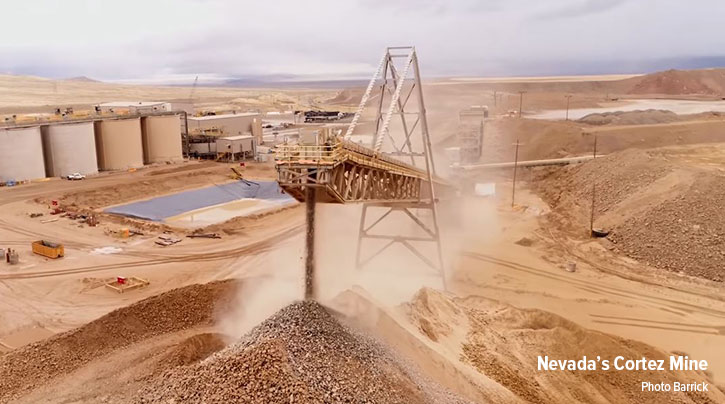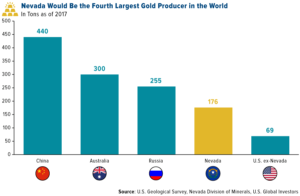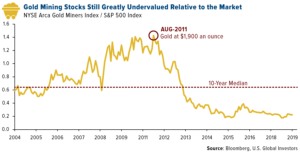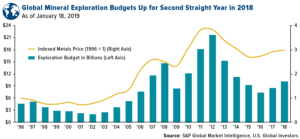
Dominating gold headlines early this year was the news of Barrick Gold’s $17.8 billion hostile takeover of longtime rival Newmont Mining that unsurprisingly failed. Instead of battling it out in the capital markets, the two gold mining giants decided to enter a joint venture (JV) in Nevada, where both have significant operations. The JV will combine several deposits and mines, processing facilities and infrastructure to unlock significant synergies.
As a standalone company, the Nevada complex will be the world’s single-largest gold producing operations, according to equity research firm GMP Securities.
Nevada, by the way, is the top gold producing state in the U.S., responsible for nearly three quarters of annual output. If it were its own country, Nevada would be the fourth largest gold producer in the world, thanks to its prolific Carlin Trend deposits.

It’s within these monumental goldfields that the Barrick-Newmont JV will be operating, with control over as many as three Tier 1 mines, or those that typically produce 500,000 ounces of gold or more annually. That is significant.
The JV ownership will be 61.5 percent Barrick and 38.5 percent Newmont, with Barrick acting as the main operator. The board will consist of three Barrick representatives and two Newmont representatives.
What’s really exciting, we think, is that the synergies are projected to come partly from optimized mining and processing and partly from supply chain and indirect costs. The synergies are estimated to help save as much as $500 million in the first five years alone, according to GMP, but we believe it could be much more than that.
It’s hard not to see this as positive for the capital markets. The Barrick-Newmont JV is about trying to drive down costs in order to sustain the overall production profiles of these two mega gold miners.
Gold Accounted for Half of World Exploration Budgets
The Barrick-Newmont deal is just the latest in what we believe is an ongoing trend of industry consolidation as well as rising exploration budgets. Barrick purchased London-based Randgold Resources back in September, while Newmont is working on a merger with Goldcorp. Australia’s Newcrest Mining just bought a majority interest in Imperial Metals’ Red Chris copper and gold mine, located in British Columbia, Canada, and is now in the process of inking a $65 million JV deal with Greatland Gold.
We view these deals as a sign that miners anticipate a bull run in gold prices. Better to spend the money now when valuations are attractive rather than later when companies could be much more expensive. During the last bull market in gold prices, many mining executives ended up losing their jobs because they entered deals when valuations were overextended.

Exploration budgets are also finally starting to climb – another sign of increased confidence in future prices. According to S&P Global Market Intelligence’s just-released “World Exploration Trends 2018,” budgets increased for the second straight year in 2018 to $10.1 billion. Roughly half of that, or $4.85 billion, was spent on gold exploration.

What all of this means is that now might be the time to consider investing in gold miners. In the years since the price of gold peaked in 2011, producers and explorers slashed budgets to keep their powder dry. We’re finally starting to see them deploy some of that capital.
Ready to Invest?
Royalty and streaming companies could also benefit from increased production and exploration by gold miners. These companies own royalties on the metals from specific projects, in exchange for helping finance the exploration and production. For example, Franco-Nevada owns royalties on four projects in Nevada that are operated by either Barrick or Newmont, which could see greater efficiency due to the JV.
We believe that both gold miners and royalty companies are a good way to invest in the gold space – that’s why we launched an ETF that provides investors access to both. The U.S. Global GO GOLD and Precious Metal Miners ETF (GOAU) invests in companies engaged in the production of precious metals either through active (mining or production) or passive (owning royalties or production streams) means.
Learn more about the ETF and its holdings by clicking here!
Past performance does not guarantee future results.
All opinions expressed and data provided are subject to change without notice. Some of these opinions may not be appropriate to every investor.
The NYSE Arca Gold Miners Index is a modified market capitalization weighted index comprised of publicly traded companies involved primarily in the mining for gold and silver. The S&P 500 Stock Index is a widely recognized capitalization-weighted index of 500 common stock prices in U.S. companies.
